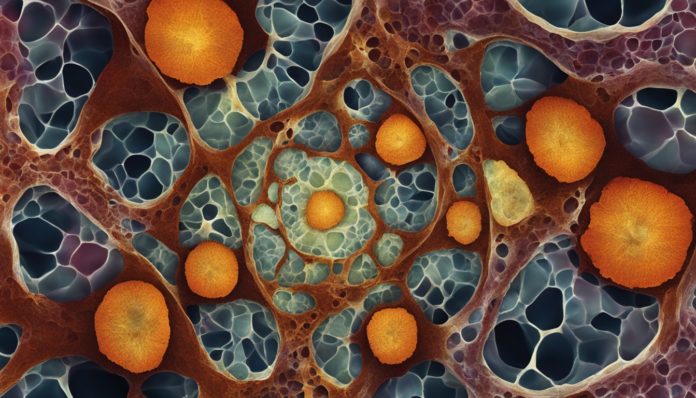Did you know that Prostate Transitional Cell Carcinoma (PTCC) is a rare type of prostate cancer? It makes up less than 5% of all prostate cancers but is much more aggressive. This cancer usually starts in men around 54 years old, which is younger than most prostate cancers.
PTCC affects the urothelial cells lining the urinary tract. It can spread fast to the bladder, lymph nodes, bones, and other organs.
Diagnosing PTCC is hard because it often doesn’t raise prostate-specific antigen (PSA) levels. PSA is a marker used to find prostate cancer. So, catching it early is key to better treatment results.
Key Takeaways
- Prostate Transitional Cell Carcinoma (PTCC) accounts for less than 5% of prostate cancers.
- PTCC primarily affects men around 54 years of age, younger than other prostate cancers.
- This type of cancer involves the urothelial cells lining the urinary tract.
- PTCC can spread quickly to the bladder, lymph nodes, bones, and other organs.
- Early detection is challenging as PTCC doesn’t typically raise PSA levels.
What is Prostate Transitional Cell Carcinoma?
Prostate Transitional Cell Carcinoma, also known as urothelial carcinoma of the prostate, is a rare and aggressive cancer. It starts in the cells lining the urinary tract in the prostate or urethra. This cancer has its own set of features and implications, making it different from other prostate cancers.

Definition and Overview
This cancer begins in the cells that line the urinary tract, mainly in the prostate. It’s known for being aggressive and spreading quickly. Catching it early and accurately is key to treating it effectively.
Prevalence and Demographics
This cancer is very rare, making up a small part of prostate cancer cases. People usually get diagnosed with it at a younger age than other prostate cancers. This shows the importance of special attention and treatment plans.
Comparisons with Other Prostate Cancers
Diagnosing transitional cell carcinoma early is harder than other prostate cancers. It often comes from the same cells as bladder cancer, showing its connection. Its symptoms can be like those of urinary tract tumors, making it harder to spot.
| Aspect | Transitional Cell Carcinoma | Other Prostate Cancers |
|---|---|---|
| Cell Origin | Urothelial Cells | Prostate Gland Cells |
| Median Age at Diagnosis | Lower | Higher |
| Metastasis Potential | High | Varies |
Causes and Risk Factors
Prostate Transitional Cell Carcinoma (TCC) is caused by both genes and environment. Knowing how these factors work together helps us understand this complex disease.

Genetic Factors
Having a genetic predisposition to prostate cancer is a big risk factor. This means having certain genetic changes or issues with genes that control cell growth. People with a family history of cancers, especially in the urinary system, face a higher urothelial carcinoma risk.
A table showing how genetic changes link to prostate cancer could be very helpful:
| Genetic Mutation | Associated Risk |
|---|---|
| BRCA1/BRCA2 | Higher risk of developing prostate cancer |
| HOXB13 | Increased susceptibility to early-onset prostate cancer |
| TP53 | Potential for aggressive cancer types |
Environmental and Lifestyle Influences
Don’t forget about the role of environmental factors in cancer. Studies show that lifestyle choices and exposures can raise the risk of prostate TCC. Smoking is a big one, linked strongly to urothelial carcinomas.
Being exposed to certain chemicals at work, like in dye, rubber, or leather industries, also ups the urothelial carcinoma risk. Having papillary or carcinoma in situ in the bladder or tumors near the bladder neck also increases the risk of prostate TCC.
Knowing about these prostate cancer risk factors is key for prevention and early action. This could help lower the chances of getting the disease.
Symptoms and Early Signs of Prostate TCC
Spotting the early signs of prostate cancer is key to early action. Prostate Transitional Cell Carcinoma (TCC) often has symptoms like other prostate issues. Knowing these signs helps in catching prostate cancer early and managing it better.
Common Symptoms
The symptoms of PTCC include:
- Difficulty urinating
- Urinary irritation
- Hematuria (blood in urine)
TCC doesn’t usually raise PSA levels like other prostate cancers. So, just PSA screening might not catch prostate cancer.
Less Common Manifestations
Diagnosing TCC can also show in less obvious ways, such as:
- Palpable hardness or lumpiness of the prostate during a digital rectal examination
- Unexplained pelvic pain
- Lower back discomfort
With these varied signs, catching the early signs of prostate cancer is crucial. Getting thorough tests is key to handling symptoms of PTCC well.
Diagnostic Tests for Prostate TCC
Finding Prostate Transitional Cell Carcinoma (TCC) is hard because it’s rare and its symptoms are not clear. The first step is usually using imaging and lab tests. A prostate biopsy is often done next, where tissue samples are taken for closer look.
Sometimes, TCC is found during a transurethral resection of the prostate (TURP) for urinary problems from an enlarged prostate. In this process, the removed tissue is checked for cancerous cells.
To tell TCC apart from other prostate cancers, doctors use a special test. This test looks for certain markers like CK7, p63, and thrombomodulin. These signs are key to correctly identifying and treating prostate cancer.
Here is a useful comparison table of common diagnostic methods:
| Method | Purpose | Effectiveness |
|---|---|---|
| Prostate Biopsy | Collect tissue samples for cancer detection. | High accuracy in identifying cancerous cells. |
| Transurethral Resection | Examine prostate tissues for TCC during TURP procedure. | Effective for initial detection in symptomatic patients. |
| Immunohistochemical Analysis | Differentiates TCC from other prostate cancers using biomarkers. | Highly effective for definitive diagnosis. |
Treatment Options for Prostate Transitional Cell Carcinoma
When dealing with PTCC, the choice of treatment depends on the cancer’s stage. This section will explore various methods, including surgery and immunotherapy advancements.
Surgical Interventions
Surgery is a key treatment for PTCC. For early-stage cancer, removing the tumor is often enough. In more severe cases, removing the prostate and bladder may be needed. These surgeries aim to remove all cancer, offering good survival chances.
Learn more about these treatments here.
Radiation Therapy
Radiation therapy is vital for treating prostate transitional cell carcinoma. It can be used after surgery to kill any leftover cancer cells. Or, it can be the main treatment for cancer that has spread.
Chemotherapy
Chemotherapy is key for PTCC that has spread. It uses drugs to target and destroy cancer cells. This is crucial for advanced cases where surgery or radiation alone may not work.
Immunotherapy
Immunotherapy is showing promise in fighting PTCC. Using Bacillus Calmette-Guérin (BCG) after surgery helps the immune system fight cancer. This method can be very effective when used with other treatments.
| Method | Scenario | Details |
|---|---|---|
| Surgery | Localized Cancer | Tumor resection, cystoprostatectomy |
| Radiation Therapy | Post-Surgery, Spread to Tissues | Eliminates residual cells |
| Chemotherapy | Metastasized Cancer | Systemic drug application |
| Immunotherapy | Post-Surgery | BCG treatments to boost immune response |
Prognosis of Prostate TCC
The prognosis of prostate TCC (transitional cell carcinoma) varies a lot. Early detection is key to better outcomes.
Survival Rates
Studies show a big range in survival rates for prostate cancer, especially with transitional cell carcinoma. The 5-year survival rates can be anywhere from 20% to 100%. This depends on when the cancer is found and where it is in the body. If the cancer stays within the prostate, treatment is more likely to work.
Factors Affecting Prognosis
Many factors affect how well PTCC patients do. These include how widespread the disease is, if it invades the prostate stroma, and how well treatments work. This collection of studies shows how important these factors are.
Prostate stroma invasion is linked to a worse prognosis. This means early and strong treatment is crucial. Tailored treatment plans based on these factors can help improve survival rates for prostate cancer.
Secondary TCC: When Bladder Cancer Metastasizes to the Prostate
Secondary prostate cancer often happens when bladder cancer metastasis reaches the prostate. This is due to the urothelial carcinoma spread. It shows how cancers from the same cell type in the urinary tract can move to other areas.
Studies show that more than 90% of prostate TCC cases come from bladder cancer metastasis. This fact highlights the importance of closely watching for cancer spread in bladder cancer patients.
Learning how cancer spreads helps in catching it early. This can lead to better treatment and less harm from the disease.
| Primary Cancer | Secondary Site | Incidence Rate |
|---|---|---|
| Bladder Cancer | Prostate | High (90%) |
| Bladder Cancer | Lymph Nodes | Moderate |
| Bladder Cancer | Bone | Low |
Doctors need to be quick in spotting secondary prostate cancer signs. This helps in starting treatment early. As research goes on, finding better ways to treat these cases is key to helping patients.
The Role of Targeted Therapy in Prostate Cancer
Targeted therapy for prostate cancer is a new way to treat the disease. It uses treatments that match the cancer’s genetic and molecular traits. This approach aims to make treatments more effective and reduce side effects. It’s important to understand the latest developments and how well these therapies work to improve future treatments.
Recent Advances
New treatments for prostate cancer focus on specific genetic and molecular issues in TCC cells. These therapies aim to hit cancer cells more accurately than old methods. Thanks to new discoveries, researchers are creating treatments that could lead to better results with fewer side effects.
Effectiveness and Limitations
Targeted therapies show great promise but have some limits. How well they work depends on the cancer’s genetic makeup. TCC is rare and often found in later stages, making treatment harder. These challenges highlight the need for more research to improve these treatments and make them more widely useful.
| Aspect | Benefits | Challenges |
|---|---|---|
| Customization | Individualized therapy based on genetic makeup | Limited applicability due to tumor variability |
| Side Effects | Potentially fewer side effects compared to traditional treatments | Long-term side effects still under study |
| Efficacy | Higher efficacy for specific genetic mutations | Limited efficacy for non-specific mutations |
Conclusion
Prostate Transitional Cell Carcinoma is a rare and aggressive type of prostate cancer. It’s hard to diagnose and treat. Finding it early is key to better outcomes and longer lives. New treatments like immunotherapy and targeted therapy bring hope, but we’re still learning about their full potential.
Understanding the genetic and molecular aspects of Prostate Transitional Cell Carcinoma is vital. This research will help us find better ways to diagnose and treat it. The field of prostate cancer care is always evolving, showing the need for specialized treatments for PTCC.
We aim to improve the outlook for Prostate Transitional Cell Carcinoma with personalized medicine and team-based care. These efforts will help patients with this complex disease. They offer hope for better health and quality of life.
FAQ
What is Prostate Transitional Cell Carcinoma?
Prostate Transitional Cell Carcinoma (PTCC), also known as urothelial carcinoma of the prostate, is a rare and aggressive form of prostate cancer. It starts in the cells lining the urinary tract.
How common is Prostate Transitional Cell Carcinoma?
PTCC is very rare, making up less than 5% of all prostate cancer cases. It usually affects men around the age of 54.
How does PTCC differ from other types of prostate cancer?
Unlike other prostate cancers, PTCC doesn’t raise PSA levels. It’s more likely to be linked to bladder cancer history. It also hits a younger group and is more aggressive.
What are the key risk factors for developing Prostate Transitional Cell Carcinoma?
Risk factors include genetic predispositions, smoking, chemical exposure, and bladder cancer or carcinoma in situ history.
What symptoms should prompt a consultation for PTCC?
Symptoms include trouble urinating, urinary irritation, blood in urine, and less often, a hard or lumpy prostate on a rectal exam.
How is Prostate Transitional Cell Carcinoma diagnosed?
Diagnosis comes from a transurethral resection of the prostate and analyzing the tissue. They look for markers like CK7, p63, and thrombomodulin.
What treatment options are available for PTCC?
Treatments include surgery, radiation, chemotherapy, and immunotherapy with Bacillus Calmette-Guérin (BCG). The choice depends on the cancer’s stage and spread.
What is the prognosis for someone diagnosed with PTCC?
The prognosis depends on the cancer’s stage at diagnosis. Survival rates range from 20% to 100% over 5 years. It’s worse if the cancer has spread.
How does bladder cancer relate to Prostate Transitional Cell Carcinoma?
Secondary TCC happens when bladder cancer spreads to the prostate. Over 90% of prostate TCC cases have a bladder cancer history.
What advancements have been made in targeted therapy for PTCC?
Advances in targeted therapy focus on treatments tailored to TCC cell genetics and molecules. This aims to improve treatment results and reduce side effects.


